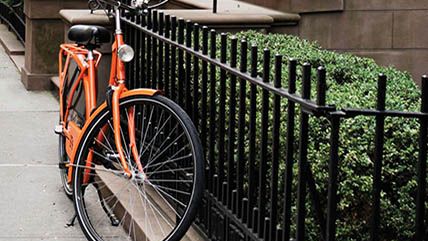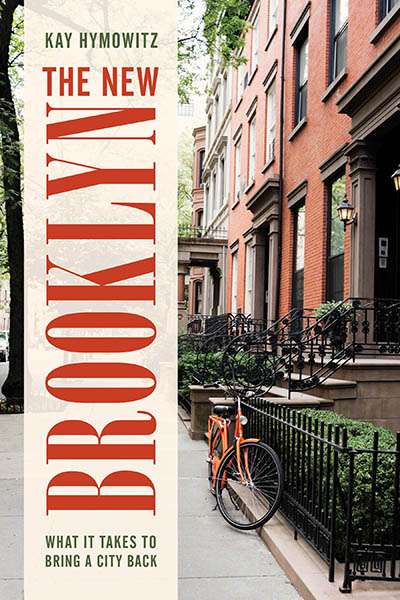From SoHo to Bushwick
A journey through New York's gentrification

The New Brooklyn: What It Takes To Bring a City Back, by Kay S. Hymowitz, Rowman & Littlefield, 198 pages, $27

Some decades ago, the great divide in New York City culture was between uptown and downtown. The former contained the prominent museums, the commercial publishers, and the WASP establishment. The latter held the less established artists and writers, the best galleries for selling recent art, and the independent intellectuals. Uptown New Yorkers often took pride in never going downtown, where people lived in shabbier lodgings, often renovated from factories. Those of us residing downtown, as I did from 1966 to 2010, thought we might get a nosebleed if we traveled north of 14th Street.
Toward the end of the last century, as downtown Manhattan became slicker, uptown people and institutions started to move downtown, often creating replicas of the areas they had left in a process commonly called gentrification. SoHo, the downtown neighborhood south of Houston Street, started as an industrial slum but became within 40 years a populous artists' colony and then a high-end shopping mall. Kay S. Hymowitz's The New Brooklyn describes how, in the late 20th century, a comparable gentrification developed across the East River in Brooklyn, a borough that had previously been a bedroom community for people who couldn't afford Manhattan.
The crucial truth of this sort of gentrification is that it's essentially extragovernmental. Politicians can't encourage it, because it starts with decisions made by individuals about where they want to live, often renovating newly purchased buildings for themselves and their partners, legal or informal. Developers, who by definition build for others, sometimes follow; other times, not. Governments customarily acknowledge gentrification at the behest of developers and voting residents, who are often in conflict with each other. In SoHo, the most extraordinary concentration of artistic excellence in American history wasn't "planned"—not by individuals and not by any public agency. Major developers never entered SoHo proper because some artists campaigned early to have it officially declared a "historic district" whose architectural integrity couldn't be violated. (The Trump SoHo hotel is actually several blocks west of SoHo proper, exploiting the neighborhood's fame at another address.)
The central setting of The New Brooklyn is Park Slope, the Brooklyn neighborhood where Hymowitz and her family moved during the 1980s. Running slightly downhill from magnificent Prospect Park to the once-polluted Gowanus Canal, it was a century ago a mostly Irish working-class neighborhood filled with uniform-looking handsome brownstones arrayed on long streets.
Into Park Slope after 1980 moved young urban professionals, customarily called yuppies, who, 'tis said, couldn't afford the similar housing found on Manhattan's Upper West Side. They renovated the brownstones, often quite elegantly and sometimes idiosyncratically, as they occupied the streets running down from the park. The lower the number of the nearby crossing avenues (running down from No. 8), the less classy the side-street housing. Different subway lines could get Park Slope residents into Manhattan within 30 minutes.
While this story of What It Takes To Bring a City Back, to quote the book's subtitle, is a good and true account for Park Slope, Hymowitz appears to know less about other Brooklyn neighborhoods with slightly different histories. Just east of there, on the other side of Flatbush Avenue, is Prospect Heights, which had fewer white people than Park Slope; east of it is Crown Heights, which is still occupied by West Indians and ultra-orthodox Lubavitcher Jews.
Well north is Boerum Hill, which had obstacles in ominous public-housing projects absent from Park Slope. Curiously, Hymowitz thinks the novelist L.J. Davis, whose 1971 book A Meaningful Life described an early Brooklyn renovation, resided in Park Slope when he actually lived in Boerum Hill.
Yet another part of Brooklyn, this one north of the active downtown area, is Williamsburg, which attracted artists who might have gone to SoHo before prices there suddenly escalated in 1980. Williamsburg offered artists empty factory buildings that were scarce in Park Slope and Boerum Hill. (Hymowitz notes that between 1950 and 2000, the number of blue-collar jobs in NYC declined from 1,000,000 to 43,000, leaving behind many empty industrial spaces now called lofts.) Indicatively, Hymowitz fails to mention the art galleries, once so populous here, perhaps because she doesn't know about them or, since they were scarce in her Park Slope, because she cannot recognize their importance in gentrification.
Though gentrification displaces people, she notes that the urban working class consists of apartment renters who are as inherently mobile as people in their 20s: Both are prepared to relocate to cheaper housing. Another truth about gentrification that she doesn't mention is that fearsome neighborhoods can be self-policing. One reason that my own Brooklyn neighborhood is not as foreboding as it used to be is that the bad guys have gone, if not to jail, at least elsewhere. During my own years here, a West Indian-Panamanian who worked evening security with his uniform suit and tie would come down my street most afternoons screaming Spanish epithets at the drug dealers operating out of a bodega and a cigar store. Now they're gone, and he's quiet.
While this book's chapters about Sunset Park and Bedford-Stuyvesant are informative, Hymowitz doesn't seem to know anything about Bushwick, which has become the favorite for artists and art lovers born after, say, 1980. The development of this "New Brooklyn" is yet more remarkable and surprising, because the 'hood resisted the efforts of urban planners for so long. What the wise guys couldn't imagine, and were slow to recognize, is that a semi-industrial neighborhood far from any large park or waterfront—as geographically distant from Park Slope as it is from Manhattan—could attract urban pioneers prepared to purchase and renovate.
The City of New York responded to these developments in the early 2000s by refurbishing the Canarsie subway line, now called the L-train, that services Bushwick. (This also benefited the developers who built high-end high-rise apartments along Williamsburg's coast on the East River.) In my 2014 book Artists' SoHo, I suggest that the current successor to SoHo is not a single circumscribed neighborhood but areas near stations along this L-train, most of which are east of Williamsburg. Now that its western precincts have become more expensive, I think gentrification will continue in Bushwick east of the Morgan Avenue stop, which has been for several years now the outpost of art galleries that have survived.
It might even reach my own (mostly Latino) neighborhood, which is four subway stops farther east, although one discouraging factor on my immediate avenue is a huge automobile junkyard with spare parts for the many small car-repair shops that constitute the principal business around here. A second obstacle is the presence, opposite the junkyard, of a vivero—a store traditionally selling live fowl. This one also offers live winsome sheep and goats, thanks to a young halal butcher in residence, and it stinks into the street, to put it mildly.
Jeuri Live Poultry Inc. has occupied its single-story building for decades, so it is likely to stay put until its customers for very fresh meat evaporate. (Free market rules.) Meanwhile, the owner of the junkyard told me recently, as he was closing his outer fence, that no developer has ever made him an offer for his land, even though the height of his piled wrecks has visibly declined over the past few years.
Conversely, my 'hood might mark an Old Brooklyn—an outlier of modest two-story residences between factories (and a mammoth Amazon distribution center), all of which resist development. Just east of me is a huge cemetery, which can't be violated. Either way, whatever happens, the city government can't move us.
This article originally appeared in print under the headline "From SoHo to Bushwick."



Show Comments (34)